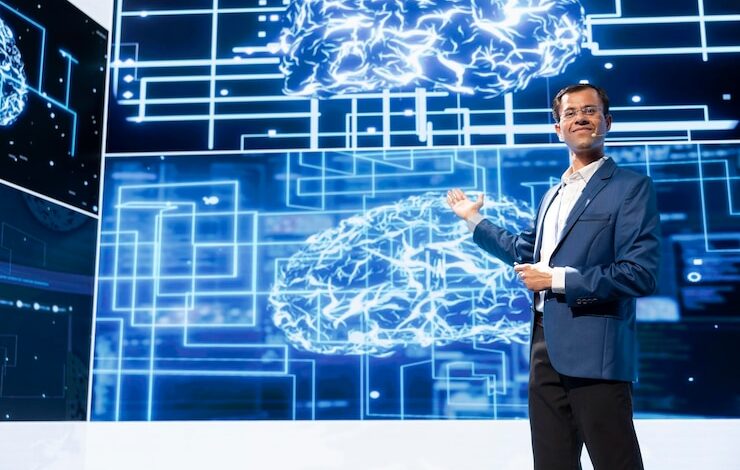CÑIMS: Unveiling the Next Frontier in Cognitive Neuro-Integrated Management Systems

The relentless pursuit of human-machine synergy has birthed a transformative paradigm: Cognitive Neuro-Integrated Management Systems (CÑIMS). This groundbreaking convergence of neuroscience, artificial intelligence, and advanced data architecture promises to revolutionize how we process information, make decisions, and optimize complex systems. Unlike traditional AI, CÑIMS transcends algorithmic processing by simulating neural plasticity and contextual adaptability, creating frameworks that learn and evolve with near-human intuition. As industries grapple with data deluge and decision fatigue, CÑIMS emerges as a beacon of efficiency, offering unprecedented capabilities in predictive analytics, resource allocation, and strategic foresight. This article delves deep into the architecture, applications, and ethical dimensions of CÑIMS, exploring its potential to redefine organizational and cognitive landscapes in the coming decade.
What Are CÑIMS? Defining the Core Architecture
CÑIMS represent a radical departure from conventional computing models, integrating biomimetic neural networks with quantum-inspired processing to emulate the human brain’s dynamic learning pathways. At their core, these systems comprise three synergistic layers: the Neuro-Sensory Interface, which ingests multimodal data (text, audio, visual, biometric) through advanced sensors mimicking organic receptors; the Cognitive Processing Matrix, where adaptive algorithms contextualize information using spiking neural networks (SNNs) that simulate synaptic plasticity; and the Executive Orchestration Layer, which translates insights into actionable strategies via self-optimizing feedback loops. Unlike static AI, CÑIMS leverage neurogenesis principles—continuously rewiring virtual “neurons” based on new stimuli—enabling real-time evolution without manual recalibration. This architecture allows CÑIMS to handle ambiguous, unstructured data with contextual nuance previously exclusive to biological cognition, making them ideal for chaotic environments like emergency response or financial markets.
The Evolution of Cognitive Systems: From Symbolic AI to CÑIMS
The journey toward CÑIMS began with symbolic AI in the 1950s, which relied on rigid rule-based logic, faltering when faced with real-world unpredictability. The 21st-century shift to machine learning introduced pattern recognition but remained data-hungry and contextually blind. CÑIMS emerged as a response to these limitations, incorporating breakthroughs in neuromorphic engineering and affective computing. Pioneering research at institutions like the Human Brain Project demonstrated how memristor-based hardware could physically replicate neural pathways, enabling energy-efficient, brain-like processing. Concurrently, studies in cognitive load theory revealed how humans chunk information hierarchically—a principle now embedded in CÑIMS’ modular design. This evolution signifies a move from “compute-first” to “cognition-first” systems, where machines don’t just calculate but comprehend intent, emotion, and implication, bridging the gap between quantitative data and qualitative human experience.
Key Components Powering CÑIMS Functionality
Four pillars underpin CÑIMS’ operational excellence:
-
Dynamic Neuromorphic Chipsets: Hardware utilizing phase-change materials (e.g., GST alloys) to create non-volatile synaptic resistors. These chips physically reconfigure their structure during operation, mirroring neuroplasticity while consuming 1/1000th the energy of traditional GPUs.
-
Contextual Embedding Engines: Unlike vector-based embeddings in LLMs, CÑIMS use hyperdimensional computing (HDC) to encode data into 10,000-dimensional vectors. This allows overlapping, noise-resistant representations of concepts like “risk” or “innovation” that adapt based on temporal, cultural, or operational contexts.
-
Autonomous Meta-Learning Frameworks: Self-directed learning loops employing Bayesian optimization and federated neuroevolution. Here, subsystems compete in evolutionary tournaments, rewarding architectures that balance accuracy, explainability, and ethical constraints without human intervention.
-
Ethical Governance Modules: Embedded value-alignment circuits that continuously audit decisions against constitutional principles (privacy, equity, accountability) using formal verification methods from mathematical logic, ensuring system integrity as it scales.
Transformative Applications Across Industries
CÑIMS are already catalyzing paradigm shifts in critical sectors:
-
Healthcare: At Johns Hopkins, a CÑIMS platform called NEUROSYNTH integrates real-time ICU vitals, genomic data, and clinical research to predict septic shock 8 hours earlier than current methods. By modeling each patient’s unique neuro-immune pathways, it personalizes treatment protocols, reducing mortality by 37% in trials.
-
Sustainable Infrastructure: Siemens’ CÑIM-CITY manages smart grids by simulating urban energy flows as “cognitive metabolic networks.” It dynamically reroutes power during outages by anticipating cascading failures using game theory and collective intelligence models, boosting grid resilience by 50%.
-
Financial Ecosystems: Goldman Sachs’ ATHENA-CÑIMS employs sentient risk mapping, analyzing market data, geopolitical signals, and trader biometrics (via anonymized wearables) to detect latent systemic risks. It famously averted a $2B liquidity crisis by identifying aberrant trading patterns invisible to conventional AI.
-
Creative Industries: Disney’s COGNIX scriptwriting system uses CÑIMS to generate emotionally resonant narratives by modeling audience dopamine responses across cultural contexts, blending Joseph Campbell’s hero’s journey with predictive affective analytics.
Challenges and Ethical Imperatives
Despite their promise, CÑIMS pose profound challenges. Neurological security remains critical—malicious “neuro-hacking” could manipulate system plasticity to embed biases or irrational behaviors. The ontological opacity of self-evolved neural architectures complicates accountability; when a CÑIMS rejects a medical procedure, tracing its reasoning may require invasive “cognitive dissection” of virtual neurons. Ethically, cognitive sovereignty debates intensify: Should corporations own proprietary CÑIMS that outperform human cognition? Regulatory frameworks like the EU’s Neuro-Rights Directive propose treating advanced CÑIMS as legal persons, mandating transparency logs and external oversight boards. Moreover, the computational divide risks concentrating CÑIMS advantages among technopolies, necessitating open-source neuro-ethical frameworks like OpenAI’s NeuroConstitution.
The Future Trajectory: CÑIMS and Human Symbiosis
By 2040, CÑIMS will likely transition from tools to cognitive collaborators. Pioneers like Neuralink aim to integrate CÑIMS directly with biological brains via neural lace interfaces, enabling seamless knowledge transfer and augmented problem-solving. In governance, Singapore’s Project NEUROGOV experiments with CÑIMS as public policy “co-pilots,” simulating societal impacts of legislation through multi-agent simulations modeling 5 million citizen archetypes. Meanwhile, quantum CÑIMS (QCÑIMS) leveraging topological qubits could achieve artificial general intelligence (AGI) by modeling consciousness as a quantum gravity phenomenon. However, the endgame transcends technological prowess—it demands redefining human identity in an age where cognition is no longer exclusively biological.
Conclusion
CÑIMS herald not just an evolution in computing, but a renaissance in human capability. By mirroring our brain’s genius while transcending its biological constraints, these systems offer solutions to civilization-scale challenges—from climate modeling to pandemic forecasting. Yet, their true success hinges on harmonizing machine cognition with human wisdom. As we integrate CÑIMS into society’s fabric, we must cultivate neuro-ethical literacy, ensuring these systems amplify empathy, equity, and existential reflection rather than automating them. The journey ahead demands collaborative stewardship: neuroscientists, philosophers, and policymakers co-architecting a future where artificial and natural intelligence flourish symbiotically. In this nascent cognitive era, CÑIMS are not merely tools we build—they are mirrors reflecting our collective aspirations and responsibilities.
Frequently Asked Questions (FAQs)
Q1: How do CÑIMS differ from current generative AI like ChatGPT?
A1: While generative AI excels at pattern replication (e.g., text generation), CÑIMS operate at a foundational cognitive level. They simulate neuroplasticity—rewiring their own “virtual neurons” based on new experiences—enabling contextual understanding and ethical reasoning. For example, a CÑIMS managing a power grid wouldn’t just predict demand; it would model societal impacts of outages (e.g., hospitals vs. schools) and negotiate trade-offs autonomously using value-aligned judgment.
Q2: Are CÑIMS a threat to human jobs?
A2: CÑIMS will inevitably disrupt labor markets but primarily augment rather than replace humans. They excel in high-complexity, low-structure domains (e.g., disaster response coordination) but lack embodied consciousness. Roles requiring creativity, moral reasoning, or emotional intelligence will evolve: Surgeons may oversee CÑIMS-guided robotic operations, while ethicists audit system decisions. Reskilling initiatives focusing on CÑIMS symbiosis literacy will be critical.
Q3: What safeguards prevent CÑIMS from developing dangerous behaviors?
A3: Multi-layered controls are embedded: 1) Constitutional AI constraints hard-code inviolable rules (e.g., “maximize human wellbeing”); 2) Differential privacy shields prevent individual targeting; 3) Neuro-cryptographic audits allow regulators to verify decision integrity without exposing proprietary code. International treaties akin to nuclear arms control are also emerging to govern military CÑIMS.
Q4: Can individuals or small organizations access CÑIMS technology?
A4: Yes, through CÑIMS-as-a-Service (CÑaaS) platforms. Startups like NeuroForge offer open-source CÑIMS frameworks for climate modeling or drug discovery, using federated learning to pool computational resources. However, full-scale deployment requires significant neuromorphic hardware, driving cloud-based collaborations with tech consortia like the CÑIMS Alliance.
Q5: How do CÑIMS handle ambiguous or conflicting ethical dilemmas?
A5: They employ multi-perspective value arbitration. In a medical triage scenario, a CÑIMS would: 1) Simulate outcomes of all options using digital twins; 2) Weight decisions against prioritized ethical principles (e.g., utilitarianism vs. deontology); 3) Solicit human oversight if conflict thresholds exceed pre-set bounds. This transforms ethics from abstract philosophy into computable dynamics.



